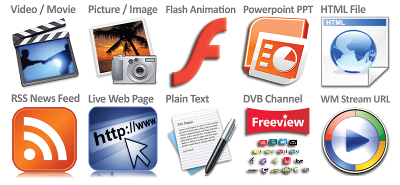
The Solus network handles a multitude of different content types, from simple static images, all the way to High Definition (HD) full motion video.
Each type of content has specific requirements; however the majority of settings apply regardless of content type.
Common Settings
Preview:
This will show you a preview of the content item in your browser. N.B. some content items may not be able to be displayed in your browser so will not be able to be previewed, they will however still display on your screen.
Duplicate:
Copies all the details about the content item and the content file itself into a new content item.

Web Report:
This produces a report showing when the content item has been shown via Solus Web TV (this only applies to content that has been published to the web and scheduled to a Web TV channel).
Filename (link):
Clicking on this allows you to download the original content file that was posted to the system. This can be useful if you wish to modify the item, but have deleted the file by mistake.
Duration:
The duration the content item should be shown for. This would normally be the length of the item; however you can shorten this to crop off the end of an item. For videos and PowerPoint items Auto Detect Duration can be set which will automatically set the duration to the length of the item therefore you do not need to worry about incorrectly shortening the length of the item.
Volume:
This specifies the volume for the content item when played on screen. You can adjust the volume down on loud items (in particular, those with background music), or adjust the volume up on quieter items such as those with only voiceovers. The default is set to 50%.
Publish:
Check the Web box to include this item in the Solus Web Guide listings. The item will automatically be converted for streaming over the Internet in a variety of formats and bandwidths.
Check the Pod box to include this message in the podcast and RSS feed. Any video will automatically be converted into the H.264 (iPod) format.
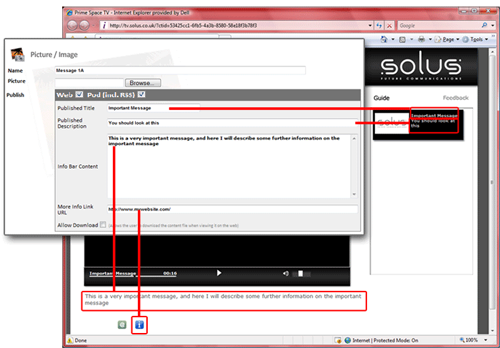
Published Title:
The content will appear on the Solus Web Guide listing under this heading.
Published Description:
The content will appear on the Solus Web Guide listing with this as the sub heading.
Info Bar Content:
When the message is playing on Solus Web TV, the message specified here will appear beneath the video in the "Info" bar.
More Info Link URL:
When a website address specified here, a "More Info" link will appear beneath the Info Bar Content text on Solus Web TV, which will take the viewer to the website when it is clicked upon.
Allow Download:
Check this box to allow the viewer of Solus Web TV to download the item for later viewing offline.
Searchable:
Check this box to allow the content to be accessible when searching on Solus Web TV.
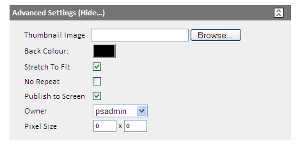
Advanced Settings:
Click on Advanced Settings to show the following extra options:
Thumbnail Image (optional):
Specify an image that will be used to represent the message in the "Guide" listing. This image should be 160x96 pixels in size, in the PNG file format. This is only required when using the Solus Web or Solus Desktop modules.
Back Colour:
Specify a colour to show through on any transparent areas of the message.
Stretch To Fit:
Check this box to stretch the message to fill the whole zone/screen. It is recommended you create content that fits the zone/screen size (see below); however this option allows you to cater for items that are not quite correct.
N.B. If the source content file and the target zone are of quite different sizes, a significant quality drop off will result. For best output quality, you should try to ensure that your content matches the zone size as far as possible.
No Repeat:
This option, when selected, stops this content item from being repeated when it is scheduled as a Timed Item. When the timed item finishes the channel will show the default Zone image until the regular items in the schedule become active again.
Publish to Screen:
By default this is selected. It should only be unchecked when an item is being prepared for publishing via Solus Web or Solus Desktop and not to a Solus Screen installation.
Aspect Ratio:
This can be automatically detected for videos, images, PowerPoint presentations and RSS feeds. This information is then used when scheduling to pre-pick the zone that matches the ratio. If the aspect ratio for a zone does not match that of the content item a warning is displayed beside the zones list. Alternatively, the Pixel Size can be set manually. If the Pixel Size does not match the original file's aspect ratio the content may appear stretched or squashed.
Owner:
Usually the owner of a content item is the user who added it. However, it is possible for site administrators to transfer ownership of an item to another user.
Video
|
|
3GP, 3G2 | Mobile Devices |
|
AVI |
Older Video Production Tools |
|
DV |
Raw camera footage |
|
MOV, QT |
Apple QuickTime / Final Cut |
|
MP4, M4V |
MPEG-4, variety of sources |
|
H264 |
As above, newer Apple software |
|
MPG, MPEG |
MPEG 1 & 2. VCD, SVCD, DVD |
|
VOB |
DVD Video Object |
|
WMV, ASF |
Windows Media (preferred) |
A wide variety of video file formats are accepted by Solus. All of the formats listed in the table below will be converted into Windows Media Video 9 format by the system automatically. For best quality & performance, it is advisable to upload videos in WMV format in the first instance. Even Windows Movie Maker (free - part of Windows) can be used to create professional looking, effective video messages.
Video Settings
When creating video, ensure you are using the following settings:
- Video Resolution: This should match the dimension of the target zone. You can also specify equivalent sizes, e.g. a 640x360 video would scale correctly for a 1280x720 zone, and a 460x288 file would scale to match a 920x576 zone
- Pixel Aspect Ratio: 1:1 (not the same as aspect ratio which is commonly 16:9)
- Frame Rate: 25 fps (frames per second)
- Bit rate: 8Mbps (Megabits per second)
Encoding Format: Windows Media Video 9 (optional)
Sony Vegas
Sony Vegas can be used to create videos for uploading to screens. Once you have created a video project & timeline, you can render the video into the correct format for display by click File -> Render As. The output WMV file can then be uploaded to the system. The settings for rendering are displayed in the following screenshots.
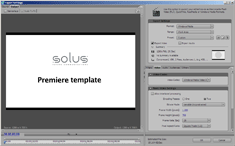
Adobe Premiere Pro
To create a file using Adobe Premiere Pro, click File->Export->Adobe Media Encoder.
Images
A static image can be created in a variety of applications including:
It can be based on a photograph, or built up using shapes and text in any image-editing
application. Bear in mind the following guidelines:
- Image Resolution: 1280x720 (or as appropriate to the target zone)
- Image Quality: 72 dpi
- Image Depth: 24-bit colour.
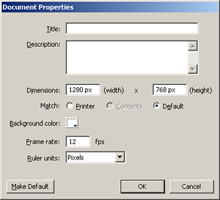
Flash
A Flash animation is created with Adobe Flash (formerly Macromedia Flash). The system will accept Flash files up to version 9. When creating Flash files, the software will produce a file ending with “.swf” or listed as “Flash Animation”. You can not upload raw Flash project files (typically ending .fla).
- Document Size: 1280x720 (or as appropriate to the target zone)
- Frame Rate: 12 fps (typically)
PowerPoint
PowerPoint presentations are created with Microsoft PowerPoint. The system will accept PPT files created in any version of PowerPoint up to PowerPoint 2003. In addition, the system will accept “PowerPoint Show” files (ending in .PPS). In PowerPoint, ensure the correct dimensions are specified in File -> Page Setup (or Design -> Page Setup in PowerPoint 2007).
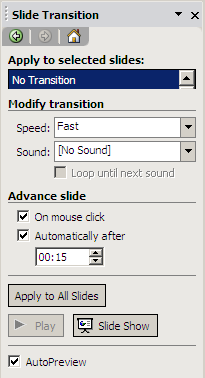
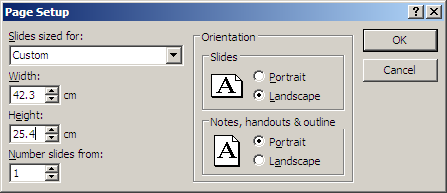
The dimensions should be appropriate to the zone that the content is targeted for.
As screens run unattended in many remote locations, it is necessary to configure the presentation to progress from one slide to the next automatically. In PowerPoint, select Slide Show -> Slide Transition (or click the Animations tab in PowerPoint 2007 or later). Select the transition you prefer, or leave it on “No Transition”, and then check “Automatically after”. Specify the time you wish the slides to appear for, and then click “Apply to All Slides”. Ensure that the total time adds up to the duration specified when uploading the content.
HTML Files
HTML web pages are developed in a variety of applications, for example:
N.B. Image files cannot be included with HTML files, so this content type is best used for formatted text. Alternatively, if images are required, they can be referenced from an external web server which must be accessible to each Display Unit when deploying to screens. This is subject to your internal IT configuration.
For large format Plasma/LCD Screen usage, web pages should be developed to display correctly at a resolution that precisely matches the target zone size.
For Solus Web usage, the site should display correctly at 640x384, and 320x192 for Solus Desktop.

RSS Feed
Solus can pull in live news feeds from the Internet. This means that your screen will display current news headlines and information that is updated automatically. RSS feeds can be found on many websites, just look for the RSS icon, pictured right.
To add an RSS feed you need to the know the address of the feed. This will be found on the website that has the feed e.g. the BBC News feed is found at http://newsrss.bbc.co.uk/rss/newsonline_uk_edition/front_page/rss.xml. Enter this address into the News Feed textbox. To check that the address is correct click View beside the address text box which will show the feed in your browser.
An RSS item consists of a headline and details. It is common to have the headlines to appear on the left and each is highlighted in turn as its details are displayed on the right. The appearance of how RSS feed items are displayed on screen can be customised as detailed below.

Items View:
Here the number of items that you want to be displayed can be set. For example if you set this to 5 it will only display the 5 most recent items. The appearence and style of the text is set here as well as its position. Its position is the co-ordinates of where it will appear inside the zone. Care should be taken to ensure that the text is big enough to be viewed on your screen.
Details View:
These settings determine how the item's details will be displayed. The duration is how long each item's details are displayed for in seconds. This should be the duration of the RSS content item divided by the number of RSS items so that each item is displayed for the same amount of time e.g. for a 30 second RSS content item containing 5 RSS items the duration should be 6 seconds.
Last Modified Text:
This is an optional feature that displays when the feed was last updated. The appearance of the text showing this can be set here.
Live Website
For displaying up-to-the-minute information directly from a dynamic website, you can specify a URL (web address) for the system to display. Web pages would be developed using similar techniques as above, again with the appropriate resolution to the target zone or output device.
URL’s should begin with “http://” and should be the full external address for a site. For example, a web page called “news.htm” on a server called “staffserver”, would likely resolve to “http://staffserver.yourorganisation.gov.uk/news.htm”. The full address is required as the SOLUS Controller Units and any external visitors to WebTV would not see the internal name. Once an address has been entered you can click "View" beside the address to make sure the address is correct.
Plain Text
Using this type of item a series of your own messages can be displayed on your screen. To display a message enter the text of the message and a value for the duration, in seconds, of how long you would like the message to be displayed for. Each message can have a different duration and the duration for the plain text content item will be calculated as the total length of all the messages. When the plain text is scheduled on screen each message will loop through in the order they appear here. Use the Customise section to specify how the messages will appear on screen or you can select a Theme, which is a predefined style for text messages. A background image can also be set here.
DVB Channel
A Freeview channel can be added as a content item if the Solus Freeview module has been installed with your screen. Select a channel from the list of DVB channels and a duration for long you would like the channel to be shown for. N.B. The DVB Tuner will need to be scanned to tune in the television channels before Freeview is available. This will be done during the installation of the screen but can also be accessed through the Channels menu. Some channels may not be available in all areas.
WM Stream URL
A WM Stream URL content item allows you to stream multimedia such as video or audio from the Internet. Enter the URL of the stream in the textbox. URL's should begin with mms:// (which is a Microsoft Media Server) or http://. To check that the URL is correct, click View which will preview the stream.